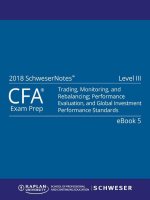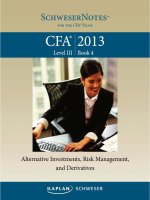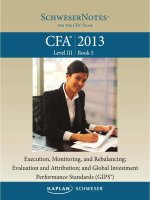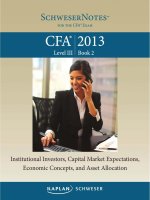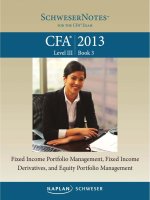Tài liệu 2018 CFA level 1 study note book2
Bạn đang xem bản rút gọn của tài liệu. Xem và tải ngay bản đầy đủ của tài liệu tại đây (6.66 MB, 231 trang )
Table of Contents
1.
2.
3.
4.
5.
6.
Getting Started Flyer
Table of Contents
Page List
Book 2: Economics
Reading Assignments and Learning Outcome Statements
Topics in Demand and Supply Analysis
1. LOS 14.a: Calculate and interpret price, income, and cross-price elasticities
of demand and describe factors that affect each measure.
2. LOS 14.b: Compare substitution and income effects.
3. LOS 14.c: Distinguish between normal goods and inferior goods.
4. LOS 14.d: Describe the phenomenon of diminishing marginal returns.
5. LOS 14.e: Determine and interpret breakeven and shutdown points of
production.
6. LOS 14.f: Describe how economies of scale and diseconomies of scale affect
costs.
7. Key Concepts
1. LOS 14.a
2. LOS 14.b
3. LOS 14.c
4. LOS 14.d
5. LOS 14.e
6. LOS 14.f
8. Concept Checkers
1. Answers – Concept Checkers
7. The Firm and Market Structures
1. LOS 15.a: Describe characteristics of perfect competition, monopolistic
competition, oligopoly, and pure monopoly.
2. LOS 15.b: Explain relationships between price, marginal revenue, marginal
cost, economic profit, and the elasticity of demand under each market
structure.
3. LOS 15.d: Describe and determine the optimal price and output for firms
under each market structure.
4. LOS 15.e: Explain factors affecting long-run equilibrium under each market
structure.
5. LOS 15.c: Describe a firm’s supply function under each market structure.
6. LOS 15.f: Describe pricing strategy under each market structure.
7. LOS 15.g: Describe the use and limitations of concentration measures in
identifying market structure.
8. LOS 15.h: Identify the type of market structure within which a firm
operates.
9. Key Concepts
1. LOS 15.a
2. LOS 15.b
3. LOS 15.c
4. LOS 15.d
5. LOS 15.e
6. LOS 15.f
7. LOS 15.g
8. LOS 15.h
10. Concept Checkers
1. Answers – Concept Checkers
8. Aggregate Output, Prices, and Economic Growth
1. LOS 16.a: Calculate and explain gross domestic product (GDP) using
expenditure and income approaches.
2. LOS 16.b: Compare the sum-of-value-added and value-of-final-output
methods of calculating GDP.
3. LOS 16.c: Compare nominal and real GDP and calculate and interpret the
GDP deflator.
4. LOS 16.d: Compare GDP, national income, personal income, and personal
disposable income.
5. LOS 16.e: Explain the fundamental relationship among saving, investment,
the fiscal balance, and the trade balance.
6. LOS 16.f: Explain the IS and LM curves and how they combine to generate
the aggregate demand curve.
7. LOS 16.g: Explain the aggregate supply curve in the short run and long run.
8. LOS 16.h: Explain causes of movements along and shifts in aggregate
demand and supply curves.
9. LOS 16.i: Describe how fluctuations in aggregate demand and aggregate
supply cause short-run changes in the economy and the business cycle.
10. LOS 16.j: Distinguish between the following types of macroeconomic
equilibria: long-run full employment, short-run recessionary gap, short-run
inflationary gap, and short-run stagflation.
11. LOS 16.k: Explain how a short-run macroeconomic equilibrium may occur
at a level above or below full employment.
12. LOS 16.l: Analyze the effect of combined changes in aggregate supply and
demand on the economy.
13. LOS 16.m: Describe sources, measurement, and sustainability of economic
growth.
14. LOS 16.n: Describe the production function approach to analyzing the
sources of economic growth.
15. LOS 16.o: Distinguish between input growth and growth of total factor
productivity as components of economic growth.
16. Key Concepts
1. LOS 16.a
2. LOS 16.b
3. LOS 16.c
4. LOS 16.d
5. LOS 16.e
6. LOS 16.f
7. LOS 16.g
8. LOS 16.h
9. LOS 16.i
10. LOS 16.j
11. LOS 16.k
12. LOS 16.l
13. LOS 16.m
14. LOS 16.n
15. LOS 16.o
17. Concept Checkers
1. Answers – Concept Checkers
9. Understanding Business Cycles
1. LOS 17.a: Describe the business cycle and its phases.
2. LOS 17.b: Describe how resource use, housing sector activity, and external
trade sector activity vary as an economy moves through the business cycle.
3. LOS 17.c: Describe theories of the business cycle.
4. LOS 17.d: Describe types of unemployment and compare measures of
unemployment.
5. LOS 17.e: Explain inflation, hyperinflation, disinflation, and deflation.
6. LOS 17.f: Explain the construction of indexes used to measure inflation.
7. LOS 17.g: Compare inflation measures, including their uses and limitations.
8. LOS 17.h: Distinguish between cost-push and demand-pull inflation.
9. LOS 17.i: Interpret a set of economic indicators and describe their uses and
limitations.
10. Key Concepts
1. LOS 17.a
2. LOS 17.b
3. LOS 17.c
4. LOS 17.d
5. LOS 17.e
6. LOS 17.f
7. LOS 17.g
8. LOS 17.h
9. LOS 17.i
11. Concept Checkers
1. Answers – Concept Checkers
10. Monetary and Fiscal Policy
1. LOS 18.a: Compare monetary and fiscal policy.
2. LOS 18.b: Describe functions and definitions of money.
2017-2018年最新CFA一级二级考点汇总中文版
(全)根据CFA最新考纲编写,比看notes还有效率
备考CFA的8大最有效资料和工具
教材/notes/核心词汇手册/考纲及解析手册/计算器讲
解、历年全真模拟题/真题/道德手册/QuickSheet/等等
全套资源获取方式随新考
季更新,永久有效!
PD
F里
所
有
资
料
扫
码
获
得
史上最全的学霸学渣党CFA考经笔记分享
扫码关注以上微信公众号:CFAer,回复
【资料】即可免费获取全套资源!此活动
永久有效!资料会常年实时更新!绝对全
面!
2017-2018年最新CFA视频音频课程及指南
除CFA资料外赠送金融、财会技能视频包+热门书籍
+1000G考证资料包
【CFA万人微信群】
需要加入我们CFA全球考友微信群的请添加CFA菌菌的微信号:374208596,备注需要加哪些
群~或直接扫下方CFA菌菌二维码即可~
所有人均先加入CFA全球考友总群再根据您的需求加入其他分群~
(2017年12月,2018年6打卡签到监督群,一级、二级、三级分群、上海、武汉、北京、成
都、南京、杭州、广州深圳、香港、海外等分群)!
备考资料、学霸考经、考试资讯免费共享!交流、答疑、互助应有尽有!快来加入我们吧!
群数量太多,文件中只是部分展示~有困难的话可以随时咨询我哦!
3.
4.
5.
6.
7.
8.
9.
10.
11.
12.
13.
14.
15.
16.
17.
18.
19.
20.
21.
LOS 18.c: Explain the money creation process.
LOS 18.d: Describe theories of the demand for and supply of money.
LOS 18.e: Describe the Fisher effect.
LOS 18.f: Describe roles and objectives of central banks.
LOS 18.g: Contrast the costs of expected and unexpected inflation.
LOS 18.h: Describe tools used to implement monetary policy.
LOS 18.i: Describe the monetary transmission mechanism.
LOS 18.j: Describe qualities of effective central banks.
LOS 18.k: Explain the relationships between monetary policy and economic
growth, inflation, interest, and exchange rates.
LOS 18.l: Contrast the use of inflation, interest rate, and exchange rate
targeting by central banks.
LOS 18.m: Determine whether a monetary policy is expansionary or
contractionary.
LOS 18.n: Describe limitations of monetary policy.
LOS 18.o: Describe roles and objectives of fiscal policy.
LOS 18.p: Describe tools of fiscal policy, including their advantages and
disadvantages.
LOS 18.q: Describe the arguments about whether the size of a national
debt relative to GDP matters.
LOS 18.r: Explain the implementation of fiscal policy and difficulties of
implementation.
LOS 18.s: Determine whether a fiscal policy is expansionary or
contractionary.
LOS 18.t: Explain the interaction of monetary and fiscal policy.
Key Concepts
1. LOS 18.a
2. LOS 18.b
3. LOS 18.c
4. LOS 18.d
5. LOS 18.e
6. LOS 18.f
7. LOS 18.g
8. LOS 18.h
9. LOS 18.i
10. LOS 18.j
11. LOS 18.k
12. LOS 18.l
13. LOS 18.m
14. LOS 18.n
15. LOS 18.o
16. LOS 18.p
17. LOS 18.q
18. LOS 18.r
19. LOS 18.s
20. LOS 18.t
22. Concept Checkers
1. Answers – Concept Checkers
11. International Trade and Capital Flows
1. LOS 19.a: Compare gross domestic product and gross national product.
2. LOS 19.b: Describe benefits and costs of international trade.
3. LOS 19.c: Distinguish between comparative advantage and absolute
advantage.
4. LOS 19.d: Compare the Ricardian and Heckscher–Ohlin models of trade and
the source(s) of comparative advantage in each model.
5. LOS 19.e: Compare types of trade and capital restrictions and their
economic implications.
6. LOS 19.f: Explain motivations for and advantages of trading blocs, common
markets, and economic unions.
7. LOS 19.g: Describe common objectives of capital restrictions imposed by
governments.
8. LOS 19.h: Describe the balance of payments accounts including their
components.
9. LOS 19.i: Explain how decisions by consumers, firms, and governments
affect the balance of payments.
10. LOS 19.j: Describe functions and objectives of the international
organizations that facilitate trade, including the World Bank, the
International Monetary Fund, and the World Trade Organization.
11. Key Concepts
1. LOS 19.a
2. LOS 19.b
3. LOS 19.c
4. LOS 19.d
5. LOS 19.e
6. LOS 19.f
7. LOS 19.g
8. LOS 19.h
9. LOS 19.i
10. LOS 19.j
12. Concept Checkers
1. Answers – Concept Checkers
12. Currency Exchange Rates
1. LOS 20.a: Define an exchange rate and distinguish between nominal and
real exchange rates and spot and forward exchange rates.
2. LOS 20.b: Describe functions of and participants in the foreign exchange
market.
3. LOS 20.c: Calculate and interpret the percentage change in a currency
relative to another currency.
4. LOS 20.d: Calculate and interpret currency cross-rates.
5. LOS 20.e: Convert forward quotations expressed on a points basis or in
percentage terms into an outright forward quotation.
6. LOS 20.f: Explain the arbitrage relationship between spot rates, forward
rates, and interest rates.
7. LOS 20.g: Calculate and interpret a forward discount or premium.
8. LOS 20.h: Calculate and interpret the forward rate consistent with the spot
rate and the interest rate in each currency.
9. LOS 20.i: Describe exchange rate regimes.
10. LOS 20.j: Explain the effects of exchange rates on countries’ international
trade and capital flows.
11. Key Concepts
1. LOS 20.a
2. LOS 20.b
3. LOS 20.c
4. LOS 20.d
5. LOS 20.e
6. LOS 20.f
7. LOS 20.g
8. LOS 20.h
9. LOS 20.i
10. LOS 20.j
12. Concept Checkers
1. Answers – Concept Checkers
13. Self-Test Assessment: Economics
1. Self-Test Assessment Answers: Economics
14. Formulas
15. Copyright
PAGE LIST
1.
2.
3.
4.
5.
6.
7.
8.
9.
10.
11.
12.
13.
14.
15.
16.
17.
18.
19.
20.
21.
22.
23.
24.
25.
26.
27.
28.
29.
30.
31.
32.
33.
34.
35.
36.
37.
38.
i
iii
iv
v
vi
vii
viii
ix
1
2
3
4
5
6
7
8
9
10
11
12
13
14
15
16
17
18
19
20
21
22
23
24
25
26
27
28
29
30
39.
40.
41.
42.
43.
44.
45.
46.
47.
48.
49.
50.
51.
52.
53.
54.
55.
56.
57.
58.
59.
60.
61.
62.
63.
64.
65.
66.
67.
68.
69.
70.
71.
72.
73.
74.
75.
76.
77.
78.
79.
80.
81.
82.
31
32
33
34
35
36
37
38
39
40
41
42
43
44
45
46
47
48
49
50
51
52
53
54
55
56
57
58
59
60
61
62
63
64
65
66
67
68
69
70
71
72
73
74
83.
84.
85.
86.
87.
88.
89.
90.
91.
92.
93.
94.
95.
96.
97.
98.
99.
100.
101.
102.
103.
104.
105.
106.
107.
108.
109.
110.
111.
112.
113.
114.
115.
116.
117.
118.
119.
120.
121.
122.
123.
124.
125.
126.
75
76
77
78
79
80
81
82
83
84
85
86
87
88
89
90
91
92
93
94
95
96
97
98
99
100
101
102
103
104
105
106
107
108
109
110
111
112
113
114
115
116
117
118
127.
128.
129.
130.
131.
132.
133.
134.
135.
136.
137.
138.
139.
140.
141.
142.
143.
144.
145.
146.
147.
148.
149.
150.
151.
152.
153.
154.
155.
156.
157.
158.
159.
160.
161.
162.
163.
164.
165.
166.
167.
168.
169.
170.
119
120
121
122
123
124
125
126
127
128
129
130
131
132
133
134
135
136
137
138
139
140
141
142
143
144
145
146
147
148
149
150
151
152
153
154
155
156
157
158
159
160
161
162
171.
172.
173.
174.
175.
176.
177.
178.
179.
180.
181.
182.
183.
184.
185.
186.
187.
188.
189.
190.
191.
192.
163
164
165
166
167
168
169
170
171
172
173
174
175
176
177
178
179
180
181
182
183
184
BOOK 2 – ECONOMICS
Reading Assignments and Learning Outcome Statements
Study Session 4 – Economics: Microeconomics and Macroeconomics
Study Session 5 – Economics: Monetary and Fiscal Policy, International Trade, and
Currency Exchange Rates
Self-Test Assessment: Economics
Formulas
READING ASSIGNMENTS AND LEARNING OUTCOME
STATEMENTS
The following material is a review of the Economics principles designed to address the
learning outcome statements set forth by CFA Institute.
STUDY SESSION 4
Reading Assignments
Economics, CFA Program Level I 2018 Curriculum (CFA Institute, 2017)
14. Topics in Demand and Supply Analysis
15. The Firm and Market Structures
16. Aggregate Output, Prices, and Economic Growth
17. Understanding Business Cycles
STUDY SESSION 5
Reading Assignments
Economics, CFA Program Level I 2018 Curriculum (CFA Institute, 2017)
18. Monetary and Fiscal Policy
19. International Trade and Capital Flows
20. Currency Exchange Rates
LEARNING OUTCOME STATEMENTS (LOS)
STUDY SESSION 4
The topical coverage corresponds with the following CFA Institute assigned
reading:
14. Topics in Demand and Supply Analysis
The candidate should be able to:
a. calculate and interpret price, income, and cross-price elasticities of demand
and describe factors that affect each measure. (page 1)
b. compare substitution and income effects. (page 7)
c. distinguish between normal goods and inferior goods. (page 9)
d. describe the phenomenon of diminishing marginal returns. (page 9)
e. determine and interpret breakeven and shutdown points of production.
(page 11)
f. describe how economies of scale and diseconomies of scale affect costs.
(page 14)
The topical coverage corresponds with the following CFA Institute assigned
reading:
15. The Firm and Market Structures
The candidate should be able to:
a. describe characteristics of perfect competition, monopolistic competition,
oligopoly, and pure monopoly. (page 20)
b. explain relationships between price, marginal revenue, marginal cost,
economic profit, and the elasticity of demand under each market structure.
(page 22)
c. describe a firm’s supply function under each market structure. (page 40)
d. describe and determine the optimal price and output for firms under each
market structure. (page 22)
e. explain factors affecting long-run equilibrium under each market structure.
(page 22)
f. describe pricing strategy under each market structure. (page 40)
g. describe the use and limitations of concentration measures in identifying
market structure. (page 41)
h. identify the type of market structure within which a firm operates. (page 43)
The topical coverage corresponds with the following CFA Institute assigned
reading:
16. Aggregate Output, Prices, and Economic Growth
The candidate should be able to:
a. calculate and explain gross domestic product (GDP) using expenditure and
income approaches. (page 52)
b. compare the sum-of-value-added and value-of-final-output methods of
calculating GDP. (page 53)
c. compare nominal and real GDP and calculate and interpret the GDP deflator.
(page 53)
d. compare GDP, national income, personal income, and personal disposable
income. (page 55)
e. explain the fundamental relationship among saving, investment, the fiscal
balance, and the trade balance. (page 56)
f. explain the IS and LM curves and how they combine to generate the
aggregate demand curve. (page 57)
g. explain the aggregate supply curve in the short run and long run. (page 61)
h. explain causes of movements along and shifts in aggregate demand and
supply curves. (page 62)
i. describe how fluctuations in aggregate demand and aggregate supply cause
short-run changes in the economy and the business cycle. (page 66)
j. distinguish between the following types of macroeconomic equilibria: longrun full employment, short-run recessionary gap, short-run inflationary gap,
and short-run stagflation. (page 66)
k. explain how a short-run macroeconomic equilibrium may occur at a level
above or below full employment. (page 66)
l. analyze the effect of combined changes in aggregate supply and demand on
the economy. (page 70)
m. describe sources, measurement, and sustainability of economic growth.
(page 71)
n. describe the production function approach to analyzing the sources of
economic growth. (page 72)
o. distinguish between input growth and growth of total factor productivity as
components of economic growth. (page 73)
The topical coverage corresponds with the following CFA Institute assigned
reading:
17. Understanding Business Cycles
The candidate should be able to:
a. describe the business cycle and its phases. (page 83)
b. describe how resource use, housing sector activity, and external trade sector
activity vary as an economy moves through the business cycle. (page 84)
c. describe theories of the business cycle. (page 87)
d. describe types of unemployment and compare measures of unemployment.
(page 88)
e. explain inflation, hyperinflation, disinflation, and deflation. (page 89)
f. explain the construction of indexes used to measure inflation. (page 90)
g. compare inflation measures, including their uses and limitations. (page 93)
h. distinguish between cost-push and demand-pull inflation. (page 94)
i. interpret a set of economic indicators and describe their uses and limitations.
(page 96)
STUDY SESSION 5
The topical coverage corresponds with the following CFA Institute assigned
reading:
18. Monetary and Fiscal Policy
The candidate should be able to:
a. compare monetary and fiscal policy. (page 105)
b. describe functions and definitions of money. (page 105)
c. explain the money creation process. (page 106)
d. describe theories of the demand for and supply of money. (page 108)
e. describe the Fisher effect. (page 110)
f. describe roles and objectives of central banks. (page 110)
g. contrast the costs of expected and unexpected inflation. (page 111)
h. describe tools used to implement monetary policy. (page 113)
i. describe the monetary transmission mechanism. (page 113)
j. describe qualities of effective central banks. (page 114)
k. explain the relationships between monetary policy and economic growth,
inflation, interest, and exchange rates. (page 115)
l. contrast the use of inflation, interest rate, and exchange rate targeting by
central banks. (page 116)
m. determine whether a monetary policy is expansionary or contractionary.
(page 117)
n. describe limitations of monetary policy. (page 118)
o. describe roles and objectives of fiscal policy. (page 119)
p. describe tools of fiscal policy, including their advantages and disadvantages.
(page 120)
q. describe the arguments about whether the size of a national debt relative to
GDP matters. (page 123)
r. explain the implementation of fiscal policy and difficulties of implementation.
(page 124)
s. determine whether a fiscal policy is expansionary or contractionary.
(page 125)
t. explain the interaction of monetary and fiscal policy. (page 125)
The topical coverage corresponds with the following CFA Institute assigned
reading:
19. International Trade and Capital Flows
The candidate should be able to:
a. compare gross domestic product and gross national product. (page 137)
b. describe benefits and costs of international trade. (page 137)
c. distinguish between comparative advantage and absolute advantage.
(page 138)
d. compare the Ricardian and Heckscher–Ohlin models of trade and the
source(s) of comparative advantage in each model. (page 140)
e. compare types of trade and capital restrictions and their economic
implications. (page 140)
f. explain motivations for and advantages of trading blocs, common markets,
and economic unions. (page 144)
g. describe common objectives of capital restrictions imposed by governments.
(page 145)
h. describe the balance of payments accounts including their components.
(page 146)
i. explain how decisions by consumers, firms, and governments affect the
balance of payments. (page 147)
j. describe functions and objectives of the international organizations that
facilitate trade, including the World Bank, the International Monetary Fund,
and the World Trade Organization. (page 148)
The topical coverage corresponds with the following CFA Institute assigned
reading:
20. Currency Exchange Rates
The candidate should be able to:
a. define an exchange rate and distinguish between nominal and real exchange
rates and spot and forward exchange rates. (page 156)
b. describe functions of and participants in the foreign exchange market.
(page 158)
c. calculate and interpret the percentage change in a currency relative to
another currency. (page 159)
d. calculate and interpret currency cross-rates. (page 159)
e. convert forward quotations expressed on a points basis or in percentage
terms into an outright forward quotation. (page 160)
f. explain the arbitrage relationship between spot rates, forward rates, and
interest rates. (page 161)
g. calculate and interpret a forward discount or premium. (page 161)
h. calculate and interpret the forward rate consistent with the spot rate and the
interest rate in each currency. (page 162)
i. describe exchange rate regimes. (page 163)
j. explain the effects of exchange rates on countries’ international trade and
capital flows. (page 165)
The following is a review of the Economics principles designed to address the learning outcome statements set
forth by CFA Institute. Cross-Reference to CFA Institute Assigned Reading #14.
TOPICS IN DEMAND AND SUPPLY ANALYSIS
Study Session 4
EXAM FOCUS
The Level I Economics curriculum assumes candidates are familiar with concepts such
as supply and demand, utility-maximizing consumers, and the product and cost curves
of firms. CFA Institute has posted three assigned readings to its website as
prerequisites for Level I Economics. If you have not studied economics before (or if it
has been a while), you should review these readings, along with the video instruction,
study notes, and review questions for each of them in your online Schweser Candidate
Resource Library to get up to speed.
LOS 14.a: Calculate and interpret price, income, and cross-price elasticities of
demand and describe factors that affect each measure.
CFA® Program Curriculum, Volume 2, page 9
Own-Price Elasticity of Demand
Own-price elasticity is a measure of the responsiveness of the quantity demanded to a
change in price. It is calculated as the ratio of the percentage change in quantity
demanded to a percentage change in price. When quantity demanded is very
responsive to a change in price, we say demand is elastic; when quantity demanded is
not very responsive to a change in price, we say that demand is inelastic. In Figure 1,
we illustrate the most extreme cases: perfectly elastic demand (at any higher price,
quantity demanded decreases to zero) and perfectly inelastic demand (a change in
price has no effect on quantity demanded).
Figure 1: Inelastic and Elastic Demand
When there are few or no good substitutes for a good, demand tends to be relatively
inelastic. Consider a drug that keeps you alive by regulating your heart. If two pills per
day keep you alive, you are unlikely to decrease your purchases if the price goes up
and also quite unlikely to increase your purchases if price goes down.
When one or more goods are very good substitutes for the good in question, demand
will tend to be very elastic. Consider two gas stations along your regular commute that
offer gasoline of equal quality. A decrease in the posted price at one station may cause
you to purchase all your gasoline there, while a price increase may lead you to
purchase all your gasoline at the other station. Remember, we calculate demand and
elasticity while holding the prices of related goods (in this case, the price of gas at the
other station) constant.
Other factors affect demand elasticity in addition to the quality and availability of
substitutes:
Portion of income spent on a good. The larger the proportion of income spent
on a good, the more elastic an individual’s demand for that good. If the price of
a preferred brand of toothpaste increases, a consumer may not change brands
or adjust the amount used if the customer prefers to simply pay the extra cost.
When housing costs increase, however, a consumer will be much more likely to
adjust consumption, because rent is a fairly large proportion of income.
Time. Elasticity of demand tends to be greater the longer the time period since
the price change. For example, when energy prices initially rise, some
adjustments to consumption are likely made quickly. Consumers can lower the
thermostat temperature. Over time, adjustments such as smaller living
quarters, better insulation, more efficient windows, and installation of
alternative heat sources are more easily made, and the effect of the price
change on consumption of energy is greater.
It is important to understand that elasticity is not slope for demand curves. Slope is
dependent on the units that price and quantity are measured in. Elasticity is not
dependent on units of measurement because it is based on percentage changes.
Figure 2 shows how elasticity changes along a linear demand curve. In the upper part
of the demand curve, elasticity is greater (in absolute value) than 1; in other words, the
percentage change in quantity demanded is greater than the percentage change in
price. In the lower part of the curve, the percentage change in quantity demanded is
smaller than the percentage change in price.
Figure 2: Price Elasticity Along a Linear Demand Curve
At point (a), in a higher price range, the price elasticity of demand is greater
than at point (c) in a lower price range.
The elasticity at point (b) is –1.0; a 1% increase in price leads to a 1% decrease
in quantity demanded. This is the point of greatest total revenue (P × Q), which
is 4.50 × 45 = $202.50.
At prices less than $4.50 (inelastic range), total revenue will increase when
price increases. The percentage decrease in quantity demanded will be less
than the percentage increase in price.
At prices above $4.50 (elastic range), a price increase will decrease total
revenue since the percentage decrease in quantity demanded will be greater
than the percentage increase in price.
An important point to consider about the price and quantity combination for which
price elasticity equals –1.0 (unit or unitary elasticity) is that total revenue (price ×
quantity) is maximized at that price. An increase in price moves us to the elastic region
of the curve so that the percentage decrease in quantity demanded is greater than the
percentage increase in price, resulting in a decrease in total revenue. A decrease in
price from the point of unitary elasticity moves us into the inelastic region of the curve
so that the percentage decrease in price is more than the percentage increase in
quantity demanded, resulting, again, in a decrease in total revenue.
Income Elasticity of Demand
Recall that one of the independent variables in our example of a demand function for
gasoline was income. The sensitivity of quantity demanded to a change in income is
termed income elasticity. Holding other independent variables constant, we can
measure income elasticity as the ratio of the percentage change in quantity demanded
to the percentage change in income.
For most goods, the sign of income elasticity is positive—an increase in income leads
to an increase in quantity demanded. Goods for which this is the case are termed
normal goods. For other goods, it may be the case that an increase in income leads to
a decrease in quantity demanded. Goods for which this is true are termed inferior
goods.
Cross Price Elasticity of Demand
Recall that some of the independent variables in a demand function are the prices of
related goods (related in the sense that their prices affect the demand for the good in
question). The ratio of the percentage change in the quantity demanded of a good to
the percentage change in the price of a related good is termed the cross price
elasticity of demand.
When an increase in the price of a related good increases demand for a good, the two
goods are substitutes. If Bread A and Bread B are two brands of bread, considered
good substitutes by many consumers, an increase in the price of one will lead
consumers to purchase more of the other (substitute the other). When the cross price
elasticity of demand is positive (price of one is up and quantity demanded for the other
is up), we say those goods are substitutes.
When an increase in the price of a related good decreases demand for a good, the two
goods are complements. If an increase in the price of automobiles (less automobiles
purchased) leads to a decrease in the demand for gasoline, they are complements.
Right shoes and left shoes are perfect complements for most of us and, as a result,
shoes are priced by the pair. If they were priced separately, there is little doubt that an
increase in the price of left shoes would decrease the quantity demanded of right
shoes. Overall, the cross price elasticity of demand is more positive the better
substitutes two goods are and more negative the better complements the two goods
are.
Calculating Elasticities
The price elasticity of demand is defined as:
Example: Calculating price elasticity of demand
A demand function for gasoline is as follows:
QDgas = 138,500 - 12,500Pgas
Calculate the price elasticity at a gasoline price of $3 per gallon.
Answer:





